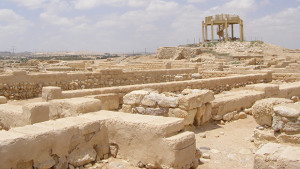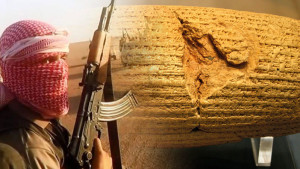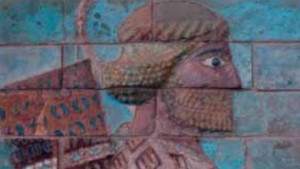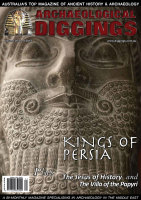Having been launched by Cyrus the Great in 550 BC and finished by Alexander the Great in 330 BC, the opulent Persian Empire lasted for more than 200 years. Between these two “Greats” much history and mischief was accomplished, both by the Persians and their neighbours alike. Furthermore, some would contend that the very survival of Western culture, which was still in its infancy, hung ever so precariously in the balance during this window of time. Indeed, were it not for the bravery of 300 Spartans (immortalized in the movie 300) or the foresight of key leaders (e.g. Themistocles), the classical civilization of Greece–and its Roman offspring–may very well have died in the cradle from a Persian sword, never to flourish and influence as it did. Further still, for the student of Scripture there are additional matters of interest in this era of Persian supremacy; in particular, what might the Bible say about this time frame, and, for those who are interested in historical studies, what correlations can be seen between this discipline and the sacred text? On this later score we are fortunately left with an abundance of both written records and material remains from the Persian period that can be compared with the Scriptures, with one section of the Bible in particular having a nice bit of numbering that can help the reader to remember its location and content. This little gem and related sections of the Bible, as well as a unique opportunity afforded in the Persian era, are discussed in more detail below.

EZRA 4
In written nomenclature our target is situated in Ezra 4: 5-7; but, if you say it aloud, the full location sounds out in nice numerical order as, “Ezra four, five, six and seven.” The actual passage, abbreviated for our purposes, reads: “…during the entire reign of Cyrus king of Persia and down to the reign of Darius king of Persia. At the beginning of the reign of Xerxes …in the days of Artaxerxes king of Persia [my emphasis].” Thus, in these three verses four Persian kings in their order of reign are laid before the reader, thereby opening the text to an examination of its historicity by the scalpel of scholars as to names, dates and details. Of particular interest in this regard is the fact that our selected section of the Bible, which was written in the 5th century BC, is contemporaneous with the advent of a new genre of non-Israelite written communication, namely, “history;” the first flowering of which we see in the Greek author Herodotus, “the father of history,” and in his immediate successors such as Thucydides, another Greek historian. Further, it is just this advent of a contemporaneous and newly developed genre in the 5th century BC that affords us with a unique opportunity that arises for the first time in the Persian era; specifically, the opportunity to utilize an additional tool, alongside traditional archaeology, in the effort to examine the historicity of the scriptural record. We must, of course, be careful about submitting the biblical text to a verification process that places these other sources on a level above the Bible in their assumed accuracy; still, comparisons and correlations can be attempted wherever various sources intersect as is the case during the reign of the Persian overlords. With these thoughts in mind, a tripartite endeavor is pursued in the following paragraphs in which selected samples of (1) Scripture, (2) historical texts [i.e. Herodotus and Thucydides] and (3) archaeological artifacts are briefly compared on a king by king basis for the purpose of considering the historicity of Ezra and related sections of the Bible.
CYRUS
 As indicated above, Ezra begins our key passage with Cyrus the Great, the founder of the Persian empire. In addition to our key text, at the beginning of his book Ezra quotes Cyrus himself as saying, “The LORD, the God of heaven, has given me all the kingdoms of the earth…” (Ezra 1:2a). Regarding this same Cyrus, Herodotus concurs with Ezra as he notes the extensive nature of Cyrus’ kingdom: “This, then, is how Cyrus was born and raised, how he became king…Cyrus ruled all of Asia.” Thus, we see Ezra and Herodotus tracking together regarding the preeminence of Cyrus. Further, the correlations between Scripture and history get even tighter when archaeological artifacts are considered, one of the most important being the Cyrus Cylinder. This object, now located in the British Museum, was discovered in Babylon in 1879 and describes how Cyrus restored the gods and temples of his conquered subjects in Mesopotamia. It reads, “I returned the [images of] the gods to the sacred centers [on the other side of] the Tigris whose sanctuaries had been abandoned for a long time, and I let them dwell in eternal abodes.” Though not specifically mentioning the Jews, the text on the cylinder lends plausibility to the account of Ezra who portrays Cyrus enacting a similar policy toward the temple in Jerusalem. Ezra says, “In the first year of King Cyrus, the king issued a decree concerning the temple of God in Jerusalem: Let the temple be rebuilt as a place to present sacrifices, and let its foundations be laid” (Ezra 6:3a). Accordingly, when seen against the background of Herodotus and the Cyrus Cylinder, Ezra’s portrayal of Cyrus is embedded nicely in the fabric of his day and age; and, not just in regard to the name and reign of Cyrus, but to a specific attitude and practice of the king as well.
As indicated above, Ezra begins our key passage with Cyrus the Great, the founder of the Persian empire. In addition to our key text, at the beginning of his book Ezra quotes Cyrus himself as saying, “The LORD, the God of heaven, has given me all the kingdoms of the earth…” (Ezra 1:2a). Regarding this same Cyrus, Herodotus concurs with Ezra as he notes the extensive nature of Cyrus’ kingdom: “This, then, is how Cyrus was born and raised, how he became king…Cyrus ruled all of Asia.” Thus, we see Ezra and Herodotus tracking together regarding the preeminence of Cyrus. Further, the correlations between Scripture and history get even tighter when archaeological artifacts are considered, one of the most important being the Cyrus Cylinder. This object, now located in the British Museum, was discovered in Babylon in 1879 and describes how Cyrus restored the gods and temples of his conquered subjects in Mesopotamia. It reads, “I returned the [images of] the gods to the sacred centers [on the other side of] the Tigris whose sanctuaries had been abandoned for a long time, and I let them dwell in eternal abodes.” Though not specifically mentioning the Jews, the text on the cylinder lends plausibility to the account of Ezra who portrays Cyrus enacting a similar policy toward the temple in Jerusalem. Ezra says, “In the first year of King Cyrus, the king issued a decree concerning the temple of God in Jerusalem: Let the temple be rebuilt as a place to present sacrifices, and let its foundations be laid” (Ezra 6:3a). Accordingly, when seen against the background of Herodotus and the Cyrus Cylinder, Ezra’s portrayal of Cyrus is embedded nicely in the fabric of his day and age; and, not just in regard to the name and reign of Cyrus, but to a specific attitude and practice of the king as well.

DARIUS
Next on Ezra’s list is Darius, who had both the good fortune of ruling a great empire and the bad fortune of encountering the Greeks. Located on the western fringe of the Persian domain and sorely lacking in political unity, the Greeks began their dustup with the Persians by attacking the city of Sardis in western Asia Minor. In order to ensure that the empire struck back, Darius employed a memory device well suited to a busy monarch. Herodotus recounts the story as follows: “…[when] word reached Darius that Sardis had been burned by the Athenians…he appointed one of his attendants to repeat to him three times whenever his dinner was served: ‘My lord, remember the Athenians.’” Apparently the device worked, though his eventual encounter with the Greeks at Marathon was not to his liking as his forces were set to flight after the battle, a story well worth the retelling. However, here we take a diversion to America, to the city of Chicago in particular, to examine an archaeological artifact located in the Persian Gallery at the Oriental Institute Museum at the University of Chicago. To say nothing of the rest of the museum, this gallery alone has roughly 1,000 objects covering many millennia, with approximately half of the material coming from the city of Persepolis, Darius’ capital. The most striking items in the exhibit are the colossal–and beautiful–animal head sculptures that come directly from Persepolis; yet, one rather small and nondescript item can serve our purposes in regard to an archaeological artifact related to Darius. This object is the standard weight that is inscribed in three languages with the following: “I [am] Darius, the Great King, King of Kings, King of Countries, King of this earth, son of Hystaspes, an Achaemenian.” Though we may disagree with some of Darius’ self assessment, based upon many objects such as this and the statements from Herodotus, we cannot disagree with his existence, nor the fact that Ezra is entrenched in real history when he discusses this king.

XERXES
And so we come to Xerxes, and here both warfare and romance come to the forefront. To start with, Herodotus, as always, has much to relate, including the Persian king’s dismay at the bravery of the 300 Spartans he met at Thermopylae. Herodotus says, “…[it] seemed quite incredible to Xerxes, and he asked for the second time how they could possibly intend to fight his whole army, since there were so few of them.” But fight they did, and the legendary valor of the Spartans still lives, both in print and on screen, even to our day. Further, though Ezra refers directly to Xerxes, a more interesting biblical portrayal of this king is actually found in the book of Esther, who was one of Xerxes’ wives. Yet, despite his fame and fortune, he was not much of a catch. Indeed, based upon the similar portrayals in both Esther and Herodotus, it appears that the king had a terrible temper. The book of Esther notes that “The king became furious and burned with anger” (Esther 1:12b), and that “The king got up in a rage…” (Esther 7:7a). In a similar vein, Herodotus relates a story of the wild anger of Xerxes when a newly built bridge was ruined in a storm. In a fit of rage, Xerxes had the bridge supervisors beheaded and the water itself whipped with a lash! As such, one scholar notes that “…Xerxes, according to both classical and biblical sources…had a nasty and at times an irrational temper.” Even so, the archaeological record is still of interest, and, for a sample of an artifact related to Xerxes, here too we can stay on the shores of the US with the large jar shown below. This object, which was found in Egypt, is located in Metropolitan Museum of Art in New York–a truly world class museum–and is inscribed with the name of Xerxes himself. Accordingly, our connections between the Bible, Herodotus, and archaeology continue to grow.

ARTAXERXES
Last but not least is Artaxerxes. Herodotus also discusses our final Persian, though for variety sake–and to extend our connections in as many directions as possible–we enlarge our network to Thucydides, the Greek historian from 400 BC. Concerning Artaxerxes, Thucydides notes, “…Themistocles…sent a letter to King Artaxerxes, Xerxes’ son, who had just come to the throne.” As quoted above, Ezra also clearly refers to Artaxerxes, but, for our biblical reference, here, too, a more in-depth portrayal of our Persian king can be found in another book, specifically, Nehemiah. Interestingly enough, Nehemiah says of himself, “I was cupbearer to the king” (Nehemiah 1:11); and, as Providence would have it, four nearly identical silver bowls used for drinking have been found with Artaxerxes’ name inscribed on them, one of which is located in the Metropolitan Museum of Art. In fact, not only Artaxerxes, but also Xerxes and Darius are named on the bowls as well, giving us a full hat trick of connections in each bowl. The inscriptions read, “Artaxerxes, the great king, king of kings, king of countries, son of Xerxes the king, of Xerxes (who was) son of Darius the king, the Achaemenian, in whose house this silver drinking-cup (was) made.” As tempting as it might be, no serious assertion can be made that Nehemiah handled any of these bowls; but, they do make a nice illustration of what he may have worked with. Further, here too we see one of Ezra’s four Persians firmly anchored in both written history and the archaeological record.

In summary, it is clear from even this brief review that there is strong resonance between all three areas of consideration: (1) Scripture, (2) historical texts, and (3) archaeological artifacts. Indeed, as one scholar has noted about the biblical portrayal of the Persian era, “We are in a clearly defined historical and cultural period with good mutual correlations.” Yet, prior to the 5th century BC emergence of a new written genre, tight correlations between the Bible and antiquity are found for the most part on seals and monumental inscriptions, and in royal archives. However, as soon as the new genre begins to develop with Herodotus, the Bible quickly begins to find strong links there as well. Further, were it not for the fact that Cicero first applied the epithet, “father of history” to Herodotus, it seems that the title could just as easily have been assigned to Ezra, or one of the preceding biblical authors. In any case, because of the demonstrable reliability of Ezra, we can have greater confidence when we consider other historical events recorded by this writer, including such matters as the following: “So we fasted and petitioned our God about this, and he answered our prayer” (Ezra 8:23).






